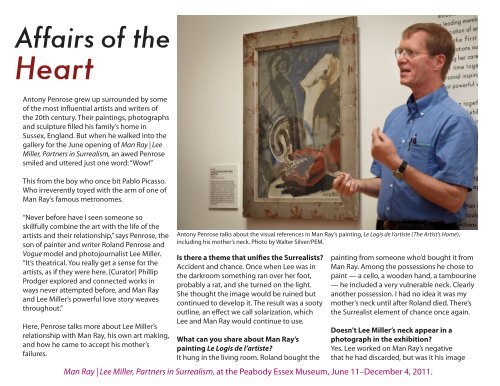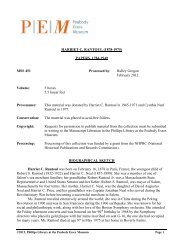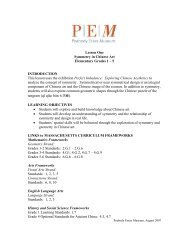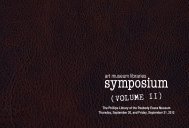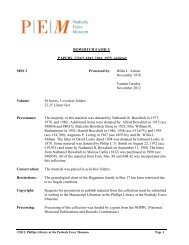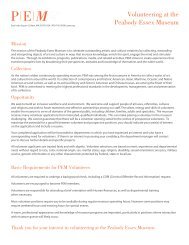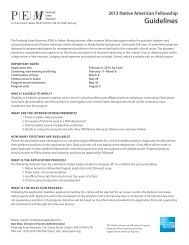Interview with Antony Penrose - Peabody Essex Museum
Interview with Antony Penrose - Peabody Essex Museum
Interview with Antony Penrose - Peabody Essex Museum
You also want an ePaper? Increase the reach of your titles
YUMPU automatically turns print PDFs into web optimized ePapers that Google loves.
Affairs of the<br />
Heart<br />
<strong>Antony</strong> <strong>Penrose</strong> grew up surrounded by some<br />
of the most influential artists and writers of<br />
the 20th century. Their paintings, photographs<br />
and sculpture filled his family’s home in<br />
Sussex, England. But when he walked into the<br />
gallery for the June opening of Man Ray | Lee<br />
Miller, Partners in Surrealism, an awed <strong>Penrose</strong><br />
smiled and uttered just one word: “Wow!”<br />
This from the boy who once bit Pablo Picasso.<br />
Who irreverently toyed <strong>with</strong> the arm of one of<br />
Man Ray’s famous metronomes.<br />
“Never before have I seen someone so<br />
skillfully combine the art <strong>with</strong> the life of the<br />
artists and their relationship,” says <strong>Penrose</strong>, the<br />
son of painter and writer Roland <strong>Penrose</strong> and<br />
Vogue model and photojournalist Lee Miller.<br />
“It’s theatrical. You really get a sense for the<br />
artists, as if they were here. [Curator] Phillip<br />
Prodger explored and connected works in<br />
ways never attempted before, and Man Ray<br />
and Lee Miller’s powerful love story weaves<br />
throughout.”<br />
Here, <strong>Penrose</strong> talks more about Lee Miller’s<br />
relationship <strong>with</strong> Man Ray, his own art making,<br />
and how he came to accept his mother’s<br />
failures.<br />
<strong>Antony</strong> <strong>Penrose</strong> talks about the visual references in Man Ray’s painting, Le Logis de l’artiste (The Artist’s Home),<br />
including his mother’s neck. Photo by Walter Silver/PEM.<br />
Is there a theme that unifies the Surrealists<br />
Accident and chance. Once when Lee was in<br />
the darkroom something ran over her foot,<br />
probably a rat, and she turned on the light.<br />
She thought the image would be ruined but<br />
continued to develop it. The result was a sooty<br />
outline, an effect we call solarization, which<br />
Lee and Man Ray would continue to use.<br />
What can you share about Man Ray’s<br />
painting Le Logis de l’artiste<br />
It hung in the living room. Roland bought the<br />
painting from someone who’d bought it from<br />
Man Ray. Among the possessions he chose to<br />
paint — a cello, a wooden hand, a tambourine<br />
— he included a very vulnerable neck. Clearly<br />
another possession. I had no idea it was my<br />
mother’s neck until after Roland died. There’s<br />
the Surrealist element of chance once again.<br />
Doesn’t Lee Miller’s neck appear in a<br />
photograph in the exhibition<br />
Yes. Lee worked on Man Ray’s negative<br />
that he had discarded, but was it his image<br />
Man Ray | Lee Miller, Partners in Surrealism, at the <strong>Peabody</strong> <strong>Essex</strong> <strong>Museum</strong>, June 11–December 4, 2011.
ecause he took the photo, or hers because<br />
she printed it They had a blazing row over<br />
attribution and she left. When she returned,<br />
she found the photo nailed to a wall, slashed<br />
<strong>with</strong> a razor and covered <strong>with</strong> blood-red ink.<br />
And her eye frequently appears in his art<br />
He always carried small photographs of Lee’s<br />
eye <strong>with</strong> him, the same eye that he affixed to<br />
the metronome, which was on a shelf in my<br />
father’s study. My friends and I would push it<br />
back and forth, watching the eye move. I was<br />
about 14 or 15 before I recognized the eye as<br />
Lee’s. Then it got more interesting. The original<br />
artwork was named Object to be Destroyed,<br />
which someone obliged him by doing.<br />
So he made many others and called them<br />
Indestructible Object.<br />
Would you say they had a complicated<br />
relationship<br />
Man Ray controlled in his art what he couldn’t<br />
do in life. He sliced Lee up and objectified her.<br />
It was also a time of free love, and the normal<br />
rules for relationships were off. It was good for<br />
men, but it wasn’t the same for women. Lee<br />
hated double standards and went off and had<br />
affairs. Man Ray became insanely jealous. It<br />
was all a struggle for control.<br />
Lee refused to be oppressed and was damn<br />
sure she was going to help others in danger<br />
of being oppressed, which is why she took up<br />
her camera at the start of the second World<br />
War. It was her weapon of choice in her fight<br />
for her friends in occupied France. In the death<br />
camps her lens was in the face of dead people,<br />
“Lee Miller was my mother. I had a very high tolerance for weird.”<br />
— <strong>Antony</strong> <strong>Penrose</strong><br />
and I am sure she was looking for her missing<br />
friends.<br />
Why did your mother have troubled<br />
relationships<br />
She felt she was a nemesis. Her first<br />
love drowned in a lake. And there were<br />
traumas in her life. She was raped at 7. As a<br />
photojournalist, she saw death and appalling<br />
human suffering. I came to see that she acted<br />
like she did not because she was feckless but<br />
because of a series of events in her life. I went<br />
through a gradual realization of my mother as<br />
a person.<br />
How did that change you<br />
The more I talk about it, the more I realize<br />
others are feeling the same way. These things<br />
aren’t generally talked about. There are very<br />
touching moments when abused women<br />
speak to me. It’s cathartic for us both and<br />
leads to a greater understanding. Again, it’s<br />
the Surrealist element of chance that I’m<br />
doing this now. With my work at the archive,<br />
I’m the pilot of a magical flying machine!<br />
I’m dedicated to the conservation and<br />
dissemination of my parents’ work and the<br />
people who associated <strong>with</strong> them.<br />
When did you come to accept your mother<br />
For the first 20 years of my life, she was lost to<br />
me, deeply affected by post-traumatic stress<br />
disorder. I never felt a maternal connection to<br />
Lee, but to Patsy, my nanny. We did become<br />
friends, thanks to my late wife, Susanna, and<br />
David E. Scherman, a photojournalist and<br />
Lee’s longtime friend. Now I’m connected<br />
intimately to this unpredictable person. She’s<br />
mothering me now, taking me on adventures<br />
and enhancing my education.<br />
What changed<br />
Lee boxed her career in the attic of the old<br />
farmhouse, a time capsule she left behind. I<br />
found it in 1978, after her death. Scherman,<br />
one of Lee’s lovers, helped edit my books,<br />
titled The Lives of Lee Miller and Lee Miller’s War.<br />
He was one of the most important people<br />
in my life. He helped me understand that<br />
my mother, whom I saw as a useless drunk,<br />
had had a career and been incredibly brave<br />
as a combat photographer <strong>with</strong> the U.S.<br />
Army Infantry in Europe. He helped me see a<br />
different side of the person I’d been embattled<br />
<strong>with</strong> all my life.<br />
How did you feel about Picasso’s Portrait of<br />
Lee Miller à l’Arlesienne<br />
It was excruciatingly embarrassing for me<br />
to have it in our home. My school chums<br />
expected to see a portrait they could<br />
recognize. They would snigger, “Does your<br />
mom really look like that It’s ugly.” Yes, she<br />
has green hair. And no, she wasn’t jaundiced,<br />
but the yellow skin shows the warmth of her<br />
personality and the intensity of her intellect<br />
(beauty only got her so far). People would say<br />
they felt like they were standing in a patch
of bright sunlight on a cold day when they<br />
were <strong>with</strong> my mother. The pink is erotic, a<br />
color you don’t see unless you get up close to<br />
somebody. The metronome shape in her chest<br />
was borrowed from Man Ray’s object. Perhaps<br />
a slightly sardonic metaphor for her heart.<br />
So, what did Picasso taste like<br />
Arty. And he smelled wonderful, of French<br />
tobacco and cologne.<br />
What’s the story behind A l’heure de<br />
l’observatoire — les amoureux<br />
Man Ray agonized over Lee Miller, spending<br />
two years painting the original eight-footwide<br />
painting of her lips, hung above his bed,<br />
working on it a little bit every morning before<br />
leaving for the studio. The lips are tilted,<br />
winging their way freely in a serene sky. It was<br />
his goodbye kiss, the moment he forgave her.<br />
In 1937 they met again and became friends<br />
again. They had an enduring friendship after<br />
World War II until their deaths, he in 1976 and<br />
she in 1977.<br />
You were a dairy farmer. Do you also make<br />
art<br />
I’m a sculptor of found things, inspired by<br />
Picasso and Man Ray. They showed me that it<br />
was normal to pick up interesting bits of junk<br />
and make things. I made a sculpture of a bra,<br />
out of barbed wire, for my late wife, Susanna.<br />
She was large breasted and people would<br />
come up to her and grab her. We were both<br />
appalled. I thought, ah, this will keep their<br />
hands off her, but she would not wear it. I<br />
guess it was because I made it way too small.<br />
Lee Miller was one of the first Surrealist street photographers. Her Exploding Hand, ca. 1930, captures a<br />
woman reaching for the door of a perfume shop, the glass scratched by countless diamond rings. Gelatin<br />
silver print. Lee Miller Archives, Sussex, England. © Lee Miller Archives, England 2011. All rights reserved.<br />
www.leemiller.co.uk<br />
Lee Miller took a photograph of a severed<br />
female breast on a plate. Any connection<br />
I didn’t know about the photograph at<br />
the time. She was rebelling against the<br />
commodification of the female body. Maybe<br />
she was saying, ”Here it is, you want it so<br />
much, eat it! You forget that behind the breast<br />
is a woman <strong>with</strong> a mind and a heart and a<br />
soul.”<br />
Why are you driven to keep the work of the<br />
Surrealists alive<br />
However you come to it, because you like<br />
photographs of ladies <strong>with</strong> no clothes on<br />
or the crazy objects or the paintings, the<br />
chances are you’ll be drawn in. It’s the bait. I<br />
want people to learn the sub-text about the<br />
changes an individual can make in the world.<br />
The Surrealists placed an intensely high value<br />
on peace, freedom and justice. Their work<br />
is really communicating about the rights of<br />
the individual. Listening to your own inner<br />
voice can make you less susceptible to being<br />
deceived by others and bending to their will.<br />
<strong>Interview</strong> conducted by Lisa Kosan, PEM director<br />
of editorial and design.


